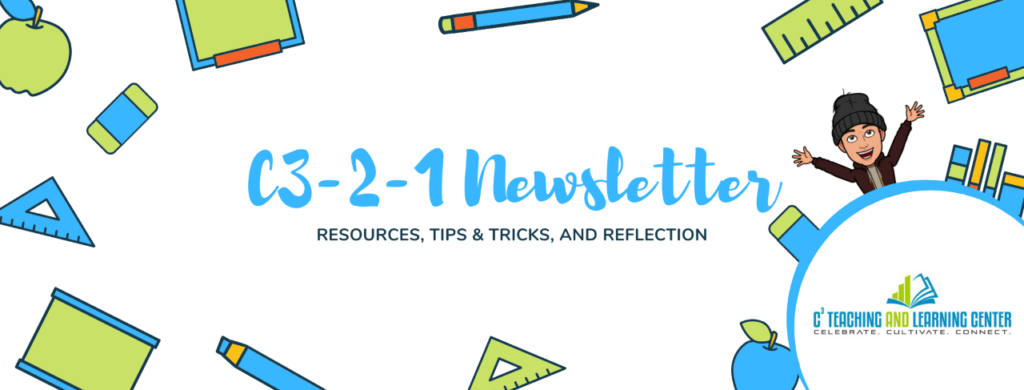C3-2-1 Newsletter – Fall 2022 Week Two!
Hello, Faculty Community!
Off and running.
These weekly newsletters feature 3 resources related to teaching and learning, 2 online tips and tricks, and 1 question for reflection.
Looking for archived resources, tips/tricks, and questions?
Revisit the past editions of the C3-2-1 Newsletter here.
Want to share?
If you have some resources, tips/tricks, and questions to share, please contribute to the newsletter using this C3-2-1 Form.

(3) Resources
- FLEX Week Revisited – As we move into week two of the fall semester, Flex Week feels like a lifetime ago. It is near impossible to participate in all of the wonderful offerings our professional development jumpstart to the academic term provides. Well, we are in luck! Aaron Roberts (PDP Coordinator / Letters) and the PDP team are keeping that busy Google Doc active so we can go back and watch the recordings of many of the sessions we might have missed or want to revisit. Please remember – time spent viewing these recordings is just as eligible for Flex as attending them live.
- A conversation about Flow State – Here, our colleagues Steve Isachsen (CSIT) and Rick White (CSIT) provide a thorough and engaging dialogue on “flow state.” We all know how it feels to be in the groove and pretty much unstoppable when we are fully immersed in something we are doing. Watch and listen for numerous examples of flow state, the science behind it, and how we can tap into this phenomenon to help us in our work and facilitate environments that can potentially get our students “flowing” – or at least steer them away from the “Zone of Delusion.”
- A Real World Approach To Deadlines – This quick read (approx. 8 minutes) interrogates commonplace ideas about deadlines and the idea that we are preparing students for the “real world” (isn’t our classroom the real world?). Robert Talbert, a mathematics professor in Michigan, discusses how to use deadlines and create clear policies on extensions effectively. Additionally, he reminds us that “clear communication solves most pedagogical problems.” Thanks to Dean Mike Fino for sending this my way.
(2) Tips & Tricks
- Canvas Overview (Students) – While many of our new students are familiar with Canvas, it never hurts to review the basics. For those new to college and Canvas, this short video and the wealth of tutorial resources can clear up a muddy start to the term. You may want to consider embedding this video into your classes, along with links to Canvas Student Guides.
- Perusall – Having students work together in the online environment is something we are constantly working to achieve. Perusall is available for us to integrate into our Canvas course to create opportunities for students to annotate the textbook collaboratively, take shared notes on pdf files, comment on videos/images/other media, and more. Here is a step-by-step guide on how to set up Perusall, coupled with a complete explanation of the features, tools, and grading options.
(1) Question
- With week one behind us, what are the similarities and differences that we have observed during yet another – but very unique – start to our school year?
Stay joyful,
Sean Davis
Joyful Teacher in Residence 🙂
Coordinator, C3 Teaching and Learning Center
Sociology Department Chair

